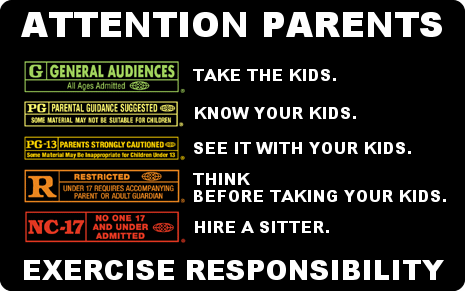Movie Ratings: Tomorrow, Now, and Then
The Motion Picture Association of America, more commonly referred to as the MPAA, has announced a change to its current rating practices. The new “Check the Box” changes will be subtle, but hopefully significant. “Check the Box” refers to the main change that we will see. The MPAA will put a clear, easier to read description of what content the movie includes that led it to merit its assigned rating; and you’ll find it right next to its letter rating.
Movies rated from PG to X made in 1990 and ever since have included a brief description of what the film is rated for. However, these descriptions have been notoriously vague and shown too quickly on the screen. The MPAA had not included any content description in its run from 1968-1990. This could seem careless to us today, but we also need to consider the fact that movies are rated much less harshly than they were circa 1968. For example, the material discussed and Jon Voight and Dustin Hoffman’s gritty performances in “Midnight Cowboy” merited the film an X rating. That rating has since been downgraded to an R. To my ears and imagination, an X and and R rated movie are two very different entities.
What did we do about movie ratings before the MPAA came along in 1968? Meet the Hays Code, so named for its champion, Postmaster General Will Hays. The Hays code included a list of “Don’ts and Be Carefuls.” At the height of the Hays Code reign, if you included a “Don’t” in your film, it would not be approved and theaters would not show it. As for “Be Carefuls,” you had to tread very lightly around those subjects or risk non-approval. The Hays Code was created and accepted as films began to include more and more bawdy behavior and negative role models.
The Hays Code was strict and had some woefully judgmental and racist clauses. However, it wasn’t entirely unpleasant. My favorite Hays Code rule was that no bad deed could go unpunished. In Tennessee William’s play “A Streetcar Named Desire,” the violent, drunken, and eventual perpetrator of sexual assault, Stanley Kowalski, is reunited with his wife Stella and his new baby even though she is aware of his crime, and his victim was her sister. In the film version the Hays Code ensured that Stella, her sister Blanche, and the new baby abandoned Stanley. Marlon Brando’s famous crying out for “Stella!” never happens in the play.
This all brings us back to today, where almost anything goes in movies, and what’s worse- we’re used to it. The MPAA’s “Check the Box” initiative can help people viewing for themselves and parents alike decide if they want to see the film, or think it’s appropriate for their children. It’s a great step, but I encourage all of us to decide for ourselves. IMDb.com frequently has descriptions of content for movies and is a great resource as well. I don’t support “censorship” as we commonly think of it, but I do censor what I watch and show in my own home. Being careful about what we show, or allow children to see, is an easy way to champion the endeavor to preserve innocence in children.
You can see the Production Code that the Hays Code developed in to here: http://productioncode.dhwritings.com/multipleframes_productioncode.php


